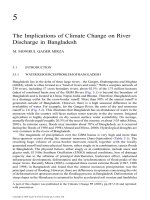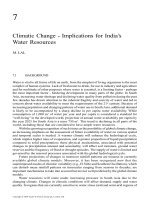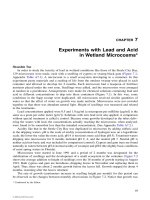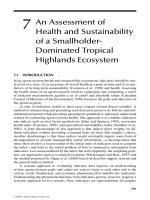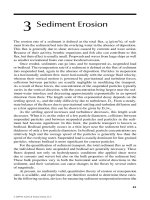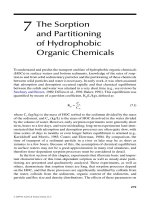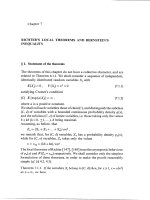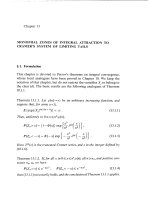ORGANIC SOILS and PEAT MATERIALS for SUSTAINABLE AGRICULTURE - CHAPTER 7 pdf
Bạn đang xem bản rút gọn của tài liệu. Xem và tải ngay bản đầy đủ của tài liệu tại đây (137.45 KB, 14 trang )
CHAPTER
7
Retention of Copper in Cu-Enriched
Organic Soils
Antoine Karam, Caroline Côté, and Léon E. Parent
CONTENTS
Abstract
I. Introduction
II. Cu Mobility and Toxicity
III. Cu Sorption
A. Theory
B. Experimental Setup
C. Results and Discussion
IV. Cu Desorption
A. Theory
B. Experimental Setup
C. Results and Discussion
V. Conclusion
References
ABSTRACT
Copper may accumulate in organic soils in the range of 2 to 60,000 mg kg
–1
,
naturally or as a result of fertilizer or biocide applications. The authors conducted
a study on Cu sorption and extraction using 28 moorsh materials varying in quality
attributes. The extraction sequence included water soluble and exchangeable Cu.
Sorption was described by the Langmuir equation with maximum sorption capacity
(X
m
) in the range of 24 to 55 g Cu kg
–1
. The X
m
was quartically related to the sum
of exchangeable basic cations (SEBC) (R
2
= 0.97). Three sorption patterns were
© 2003 by CRC Press LLC
found: X
m
was constant for SEBC values below 45 cmol
c
kg,
–1
then increased in
proportion of SEBC up to 85 cmol
c
kg,
–1
and finally increased at a lower rate for
higher SEBC values. The H
2
O- and KNO
3
-extractable Cu from added Cu at assumed
toxic level (3000 mg Cu kg
–1
) was cubically related to SEBC and pH; it was highest
below a SEBC value of 45 cmol
c
kg
–1
or a pH (0.01 M CaCl
2
) value of 4.2, then
declined to reach a plateau. The Cu sorption and desorption capacities in organic
soils can be assessed from easily determined properties such as SEBC and pH.
I. INTRODUCTION
The Cu content is generally low in organic soils (Lévesque and Mathur, 1983a;
Mengel and Rehm, 2000) compared with mineral soils (Jasmin and Hamilton, 1980).
In Canada, Cu content varied from 1.9 mg kg
–1
in a Newfoundland bog (Mathur
and Rayment, 1977) to 60,000 mg kg
–1
in a cupriferrous New Brunswick bog (Boyle,
1977); however, normal Cu content is in the range of 8.3 to 537.5 mg total Cu kg
–1
in Canadian moorsh soils (Lévesque and Mathur, 1986; Mathur et al., 1989).
The strong ability of humic substances (HS) to form stable complexes with Cu
is a major cause of Cu deficiency in soils (Matsuda and Ikuta, 1969; Mortvedt,
2000). Organic soils containing less than 20–30 mg total Cu kg
–1
in the moorsh
layers are considered deficient (Lucas, 1982). The recommended Cu application
rates in organic soils range between 10 and 20 kg Cu ha
–1
every 3 years (CPVQ,
1996). At such rates, Cu is harmless to the environment (Hamilton, 1979; Mathur
et al., 1979a; Preston et al., 1981).
The Cu may accumulate to levels exceeding agronomic requirements either
naturally or through human activities. The Cu enrichment in peats is due in part to
the formation of stable complexes with organic macromolecules (Leeper, 1978;
Shotyk et al., 1992). The HS can release Cu in amounts suitable for plant growth
(Donahue et al., 1983; Tan, 1998). The Na
4
P
2
O
7
-extractable Cu, whereby humic
acids (HA) and fulvic acids (FA) are also extracted, is thus considered to be the
most available form to plants (Viets, 1962); however, Cu linked to HA and humins
is considered to be less available to the plants than Cu linked to the lower molecular
weight FA (Preston et al., 1981; Schnitzer and Khan, 1972; Szalay et al., 1975).
Brennan et al. (1980) found that availability of freshly applied Cu to wheat decreased
by 70% with incubation time up to 120 days. Brennan et al. (1983) also found that
fresh wheat straw decreased Cu availability when applied at rates of 2.5 to 10 g per
100 g in a Lancelin soil containing 0.8% organic matter (OM).
The aim of this chapter is to examine the effect of soil properties on Cu sorption
and desorption in Cu-enriched moorsh soils.
II. CU MOBILITY AND TOXICITY
In organic and acid mineral soils, soil organic matter (SOM) is the dominant Cu
sorbent (Stevenson, 1982). Because peats are known to sequestrate Cu (Boyle, 1977),
© 2003 by CRC Press LLC
to sorb high amounts of applied Cu (Parent and Perron, 1983), and to form stable
complexes with Cu (Basu et al., 1964; Bunzl et al., 1976; Schnitzer, 1978), low to
moderate Cu additions are unlikely to contribute to the pollution of groundwater
(Hamilton, 1979; Mathur et al., 1979a) or to initiate Cu leaching (Preston et al.,
1981). The formation of metal-organic complexes must influence the concentration
and mobility of Cu
2+
in soils (Cavallaro and McBride, 1978). At high Cu rates and
in presence of high amounts of FA, Cu is mainly sequestered as soluble organic
complexes (McBride and Blasiak, 1979; McLaren et al., 1981). The humus immo-
bilizes a high proportion of the Cu applied at a low rate. Intensive decomposition
of humus or oxidation of moorsh soils must contribute to the release of Cu from
humates in a form more available to plants; however, Cu is generally considered as
relatively immobile in organic soils.
Phytotoxicity of soil Cu is controlled by sorption and desorption reactions as
related to pH, cation exchange capacity (CEC), SOM content, and the soil capacity
to supply P, Ca, and Fe to plants (Leeper, 1978; Mathur and Lévesque, 1983). Sorbed
Cu is partially reversible (Kadlec and Rathbun, 1983), therefore, Cu may become
toxic above a threshold concentration. The threshold of Cu phytoxicity in organic
soils can be predicted to some extent by CEC. Lévesque and Mathur (1984) con-
cluded that the threshold of soil-Cu toxicity in vegetable crops was about 5% of
CEC or 16 mg total Cu kg
–1
for each cmol
c
kg
–1
of CEC as determined by the neutral
ammonium acetate method.
Bear (1957) found that applications of as much as 11,200 kg Cu ha
–1
or 28,000
mg Cu kg
–1
to organic soil materials containing low amounts of plant-available
Cu did not retard plant growth. Plants not responding strongly to Cu can be grown
in moorsh soils containing up to 1063 mg kg
–1
of Cu without adverse effects on
yield (Mathur and Lévesque, 1983). An experiment involving the application of
Cu to moorsh soils in amounts that result in EDTA-Cu levels more than 1148
times the plant requirements did not increase Cu concentration in oat grain or
straw (Mathur et al., 1979a). Lévesque and Mathur (1983a) concluded that the
enrichment of moorsh soils up to 100 mg Cu kg
–1
are not phytotoxic.
Copper mitigates subsidence through its ability to inactivate degradative soil
enzymes taking part in SOM mineralization (Bowen, 1966; Mathur and Rayment,
1977; Mathur and Sanderson, 1978; Mathur et al., 1979b; Mathur et al., 1980;
Mathur, 1983). Levels of 100, 200, 300, and 400 mg total Cu kg
–1
in organic soils
with bulk densities of 0.1, 0.2, 0.3, and 0.4 g cm
3
, respectively, must be maintained
in order to reduce the subsidence rate by 50% (Mathur et al., 1979b; Mathur,
1982a, b; Lévesque and Mathur, 1984). A rate of 100 kg Cu ha
–1
during the first
few years of cultivation is effective in mitigating subsidence (Mathur et al., 1979b;
Preston et al., 1981). In comparison, up to 15 kg Cu ha
–1
are normally applied
yearly to newly reclaimed organic soils during the first 3 years of cultivation, and
then 5 kg Cu ha
–1
every second or third year (Lévesque and Mathur, 1984).
Lévesque and Mathur (1983b, 1984) reported that Cu addition at three times the
rate for mitigating subsidence by about 50% would not adversely affect the growth
or nutrition of crops grown in this soil.
© 2003 by CRC Press LLC
III. CU SORPTION
A. Theory
The Cu content in plants is controlled mainly by Cu concentration in the soil
solution as determined by sorption reactions (McLaren and Crawford, 1973). Sorption
of Cu is influenced by many soil properties such as HS, clay, carbonate, as well as
oxides of Al, Fe, and Mn, pH, CEC, exchangeable cations, mineralogy, ionic strength,
and soil solution composition (Kishk and Hassan, 1973; Harter, 1979; Dhillon et al.,
1981; Duquette and Hendershot, 1990; Basta and Tabatabai, 1992a). The ability of
HA and FA to remove trace metals from solution is well documented (Basu et al.,
1964; Ellis and Knezek, 1972; Rachid, 1974; Christensen et al., 1998; Ravat et al.,
2000). Sorption of Cu by organic soils occurs at a high rate, depending on the initial
concentration of Cu in solution (Sapek, 1976; Sapek and Zebrowski, 1976).
Metal binding sites on HS are heterogeneous (Schnitzer, 1969; Petruzzelli et al.,
1981; Murray and Linder, 1983; Christensen et al., 1998). The HA in peat (Szalay
and
Szilágyi
, 1968) is stable and highly reactive (Senesi et al., 1989). Goodman and
Cheshire (1976) as well as Abdul-Halim et al. (1981) suggested that small quantities
of Cu
2+
are tightly bound to HA through a porphyrin-type linkage. Interactions of
Cu with HS involve outer sphere complexation (electrostatic attraction), ion
exchange, inner sphere complexation, precipitation, and dissolution as a function of
acidic functional groups in HS, pH, and ionic strength (McBride, 1994, Kabata-
Pendias, 2001). Because Cu can form inner-sphere complexes with organic ligands
(Sposito, 1984), more Cu must remain in soil solution as competition with H
+
ions
increases. Manganese, Fe, and Al oxides can sorb Cu
2+
more strongly than most
divalent metals (McBride, 2000). The Mn oxides show high selectivity for Cu
2+
(McKenzie, 1980); however, chelated Mn in moorsh soils (Lévesque and Mathur,
1983b) can be easily displaced by Cu
2+
. The Fe and Mn oxides and hydroxides adsorb
trace metals due to their high surface areas coupled with the ability of Cu
2+
to replace
Fe
2+
in some Fe-oxides (Taylor, 1965; Tessier et al., 1979; Hickey and Kittrick, 1984).
B. Experimental Setup
The authors conducted two laboratory experiments on Cu sorption and desorption
using 28 moorsh soil materials (0–15 cm) from southwestern Quebec, Canada, and
showing a wide range of chemical properties. Soil samples were air-dried, sieved
to <2 mm, and stored at room temperature until use. Soil properties were determined
by standard methods (McKeague, 1978; Karam, 1993), and included pH in CaCl
2
0.01 M; SOM by combustion (550°C), ammonium acetate-extractable Ca, Mg, and
K; acid–ammonium–oxalate-extractable Fe, Al, and Mn; and sodium pyrophosphate-
extractable Fe, Al, and Mn. Acid ammonium oxalate extracts amorphous Fe, Al, and
Mn oxides and metals complexed to SOM, whereas sodium pyrophosphate extracts
Fe, Al, and Mn associated with SOM (McKeague, 1978). The CEC at pH 7.0 was
calculated as the SEBC plus exchangeable acidity. Total Cu was determined after
acid digestion (Page et al., 1982). Metal (Cu, Fe, Al, and Mn) concentrations were
determined by atomic absorption spectrophotometry.
© 2003 by CRC Press LLC
Chemical properties are presented in Table 7.1. The CEC varied between 57 and
187 cmol
c
kg
–1
, averaging 148 cmol
c
kg
–1
, which is a value between those obtained
by Lévesque and Mathur (1986) for other Quebec moorsh soils, and by MacLean
et al. (1964) for other eastern Canadian organic soils. Exchangeable acidity varied
from 12 to 141 cmol
c
kg
–1
, averaging 52% of CEC. A linear relationship existed
between OM content and CEC (r = 0.868, P < 0.001). Total Cu content ranged from
9 to 79 mg kg
–1
, averaging 44 mg kg
–1
, lower than the mean value of 145 (8 to 538)
obtained by Mathur and Lévesque (1989). The pH averaged 5.4 in the range of 4.1
to 6.7.
The Cu additions varied between 3000 and 60,000 mg Cu kg
–1
, the maximum
value for Cu accumulation in organic soils (Boyle, 1977). The 3000 mg Cu kg
–1
treatment exceeded slightly the toxic level of 16 mg total Cu kg
–1
per cmol
c
kg
–1
of CEC (Levesque and Mathur, 1984) for the highest CEC value among our
moorsh soils (187 cmol
c
kg
–1
times 16 is 2992 mg Cu kg
–1
). Sorption of Cu was
conducted as follows: one-gram sample was weighed into each of six 50-mL
polyethylene centrifuge tubes and 30 mL of a 0.01 M CaCl
2
.2H
2
O solution
containing 0, 100, 500, 1000, 1500, or 2000 mg L
–1
of Cu as CuSO
4
.2H
2
O, thus
providing 0; 3000; 15,000; 30,000; 45,000; or 60,000 mg Cu kg
–1
soil, respectively.
Soil suspensions were allowed to equilibrate for 48 h at room temperature with
occasional shaking, then they were centrifuged and decanted. The supernatant
solution was analyzed for Cu by atomic absorption spectrophotometry. The
amount of Cu sorbed was computed as the difference between initial concentration
added and that remaining in the supernatant solution. Sorption maximum capacity
(X
m
) was computed using the linearized version of the Langmuir equation (Bohn
et al., 2001) as follows:
C/X = 1/(kX
m
) + CX
m
(7.1)
where C is Cu concentration in the equilibrium solution (mg L
–1
), X is the amount
of Cu sorbed (mg kg
–1
), X
m
is maximum sorption capacity (mg Cu kg
–1
soil), and
k is a constant thought to be related to the bonding energy (L mg
–1
sorbed Cu).
Sorption isotherms showed a goodness-of-fit (r
2
) of 0.993 or more (SAS Institute,
1990). The X
m
is of agronomic and environmental importance as a measure of the
soil capacity to retain Cu. The k value is difficult to interpret in multisite systems.
Parameters k and X
m
may not have any particular chemical meaning when a reaction
mechanism other than adsorption occurs (Veith and Sposito, 1977).
C. Results and Discussion
The X
m
varied from 24,326 to 55,157 mg kg
–1
(Table 7.1), in agreement with
those obtained by Goodman and Cheshire (1973), and Parent and Perron (1983).
With the exception of few samples, mean values for X
m
were lower the more acidic
the soil. Assuming that Cu was sorbed as Cu
2+
, X
m
varied between 77 and 174 cmol
c
kg
–1
, averaging 85% of CEC; 24 soils gave X
m
values in the range of 46.1 to 98.3%
of CEC.
© 2003 by CRC Press LLC
Table 7.1 Chemical Properties of 28 Organic Soil Materials from Southwestern Quebec
Sample
(%)
SOM pH
(cmol
c
kg
–1
) (mg kg
–1
)
X
m
(cmol
c
kg
–1
)
Ca
2+
exch
Mg
2+
exch
K
+
exch
SEBC H
+
exch
CEC Fe
ox
Fe
pyr
Al
ox
Al
pyr
Mn
ox
Mn
pyr
Cu X
m
1 77.7 5.74 53.3 6.7 1.35 61.4 71.1 133 4966 3255 4544 3440 176 137 63 37,891 119
2 79.6 4.80 52.1 8.6 0.53 61.2 98.7 160 9946 7042 4594 3460 152 143 56 35,122 111
3 33.1 6.58 39.1 5.2 0.61 44.9 12.5 57 5510 3033 1677 1215 220 163 35 25,491 80
4 89.6 5.55 56.4 9.7 1.41 67.5 78.4 146 1613 333 1191 822 59 47 35 39,093 123
5 91.1 4.09 27.5 4.9 1.80 34.2 131.9 166 2241 1228 1486 1362 43 62 9 24,326 77
6 91.1 4.96 56.4 12.6 0.96 70.0 95.8 166 3962 1713 1468 1135 262 232 10 41,862 132
7 92.2 4.72 46.7 13.1 1.38 61.2 115.1 176 1190 133 715 485 50 43 24 37,717 119
8 83.1 6.69 90.8 7.8 0.36 99.0 66.4 165 8802 3763 3322 2025 704 473 34 50,648 160
9 77.0 5.51 61.9 10.7 1.38 74.0 62.3 136 3378 1587 1938 1423 122 110 65 43,286 136
10 92.4 4.07 29.3 7.2 2.06 38.6 140.6 179 1118 515 1194 1042 43 58 17 28,423 90
11 84.8 5.15 63.2 17.5 0.55 81.3 73.9 155 2466 795 1269 898 106 88 31 48,347 152
12 83.8 6.02 82.8 12.0 1.12 95.9 65.1 161 5598 3658 1859 1432 309 138 57 50,100 158
13 83.7 5.43 56.3 17.5 0.41 74.2 77.9 152 4370 2795 2419 1845 207 160 23 44,595 140
14 84.7 5.90 62.8 9.6 0.63 73.0 72.7 146 7878 5633 3014 2487 408 342 72 43,689 138
15 86.9 5.42 55.9 8.8 1.25 66.0 75.9 142 2233 837 1841 1245 93 80 77 37,896 119
16 91.5 4.88 45.3 6.4 1.48 53.2 91.1 144 1402 472 1209 957 137 108 42 31,080 98
17 77.3 6.07 61.8 5.6 2.22 69.6 50.5 120 3010 1303 1427 1075 74 55 70 44,454 140
18 86.1 5.90 60.2 7.3 1.88 69.4 70.0 139 2199 847 1203 957 58 53 47 42,033 132
19 89.0 5.68 60.8 16.1 1.31 78.2 71.4 150 4222 2347 1814 1483 284 252 79 45,623 144
20 92.7 4.66 39.4 10.4 1.44 51.2 102.8 154 2197 842 978 755 35 30 31 30,815 97
21 87.3 5.65 64.6 8.0 1.12 73.7 72.2 146 8910 6477 3363 2908 424 383 64 43,316 136
22 86.9 5.37 74.9 13.3 1.66 89.9 76.0 166 4194 1862 1153 820 540 442 36 48,940 154
23 79.8 5.85 91.0 16.7 0.74 108.4 78.4 187 3001 1435 957 725 145 123 48 55,157 174
24 92.2 4.42 41.5 11.4 0.82 53.7 115.8 170 2742 1178 774 607 78 77 29 34,563 109
25 90.7 4.64 48.9 10.0 1.65 60.6 106.0 167 1948 840 1478 1417 82 73 28 38,959 123
26 45.2 6.36 42.8 13.3 0.77 56.9 31.1 88 6266 3425 3419 1953 249 188 52 31,454 99
27 59.0 5.57 45.8 11.6 0.66 58.1 57.7 116 6890 4780 3480 2290 235 210 71 34,014 107
28 86.3 5.39 66.5 14.7 0.89 82.1 74.1 156 3000 1587 2582 1953 119 90 39 48,819 154
Note: SOM = soil organic matter content; pH = pH in 0.01M CaCl
2
; exch = exchangeable; SEBC = sum of exchangeable cations; CEC = cation exchange
capacity; ox = oxalate; pyr = pyrophosphate; Cu = total Cu; X
m
= Langmuir sorption maximum.
© 2003 by CRC Press LLC
Average pH of equilibrium solutions decreased from 6.46 (control) to 4.06
(highest Cu rate), which indicated competition between Cu
2+
and H
+
, for organic
sorption sites, particularly in the higher concentration range of Cu (Beckwith, 1959;
Schnitzer and Skinner, 1963; Khan, 1969), or a change in Cu hydrolysis state with
an increasing Cu application rate (Jarvis, 1981; Basta and Tabatabai, 1992b).
Soil pH and related soil parameters, such as SEBC and CEC, can control the behavior
of Cu in organic soils receiving appreciable amounts of Cu (Ravat et al., 2000). The X
m
values were highly correlated with SEBC, and exchangeable calcium (Exch-Ca), but
weakly correlated to pH, CEC, oxalate-extractable Mn (Mn
ox
), and pyrophosphate-
extractable Mn (Mn
pyr
). A high correlation with SEBC (r = 0.965, P < 0.001) was also
found by Harter (1979) and Basta and Tabatatai (1992a, 1992b). Indeed, Cu
2+
can replace
Ca
2+
and Mg
2+
on exchange sites (Harter, 1992). According to Alberts and Giesy (1983),
Cu competes effectively with Ca for binding sites due to its higher stability constant with
organics compared to Ca. The quartic relationship between SEBC and X
m
(Figure 7.1)
shows three sorption patterns: a plateau of constant sorption capacity for SEBC < 45
cmol
c
kg
–1
, a trend of a high rate of increase in Cu sorption capacity between 45 and 85
cmol
c
kg
–1
, followed by a trend of a smaller rate of Cu sorption capacity with SEBC >
85 cmol
c
kg
–1
. As SOM contents come closer to 30% (soil 3) or SEBC values drop to
less than 40 cmol
c
kg
–1
(soils 5 and 10), Cu sorption capacity decreases markedly
(Table 7.1).
IV. CU DESORPTION
A. Theory
Water soluble and exchangeable forms of Cu
2+
are important sources of Cu for
crop production. Briefly, those Cu forms are sequentially extracted using distilled
Figure 7.1 Relationship between the sum of exchangeable cations and the Langmuir Cu
sorption capacity in cultivated organic soils.
y = 0.00002x
4
- 0.0049x
3
+ 0.523x
2
- 22.04x + 396
R
2
= 0.966
0
20
40
60
80
100
120
140
160
180
200
30 40 50 60 70 80 90 100 110
Critical value
Cu sorption capacity (cmol
c
kg
-1
)
Sum of exchangeable basic cations (cmol
c
kg
-1
)
© 2003 by CRC Press LLC
water (H
2
O) for 2 h, followed by 0.5 M KNO
3
for 16 h (Sposito et al., 1982). The
water-soluble (H
2
O) plus exchangeable (KNO
3
) Cu content is widely regarded as a
satisfactory measure of the ability of a soil to supply cationic micronutrients for plant
growth (Lévesque and Mathur, 1988), therefore, high loads of Cu may produce toxic
amounts of available Cu and perhaps also leachable Cu. As a result, desorption of
water-soluble and exchangeable Cu is also crucial in environmental chemistry (Boyle,
1977). Schnitzer and Khan (1972) emphasized the importance of initial soil pH on
availability and mobility of Cu
H2O+KNO3
. Verloo et al. (1973) found that desorption
and mobilization of soil Cu became significant as equilibrium pH fell toward 3.0.
B. Experimental Setup
The addition of 3000 mg Cu kg
–1
increased CEC saturation from 0.10 ± 0.06%
in the control to 6.9 ± 2.3% in Cu-treated samples in average, thus close to the 5%
phytotoxicity threshold proposed by Lévesque and Mathur (1984). The water-soluble
and exchangeable Cu (Sposito et al., 1982) was examined in soils treated with the
3000 mg Cu kg
–1
application rate, which was slightly above the toxic level.
C. Results and Discussion
As shown in Figure 7.2 for moorsh soil materials containing more than 45%
SOM, Cu
H2O+KNO3
decreased cubically with SEBC. As SEBC decreased, Cu com-
peted more with protons. A critical value for Cu
H2O+KNO3
was found graphically at
a SEBC of 45 cmol
c
kg
–1
, in keeping with the lower critical value for Cu sorption
Figure 7.2 Relationship between the sum of exchangeable cations and readily available (sum
of the H
2
O and KNO
3
fractions) Cu from added Cu at toxic level (3000 kg mg
–1
).
y = -0.000238x
3
+ 0.0580x
2
- 4.66x + 137
R
2
= 0.85
0
5
10
15
20
25
30
35
40
45
0 10 20 30 40 50 60 70 80 90 100 110 120
Sum of exchangeable basic cations (cmol
c
kg
-1
)
Readily available Cu (mg kg
-1
)
Critical value
© 2003 by CRC Press LLC
(Figure 7.1). Thereafter, Cu
H2O+KNO3
decreased. Negative relationships between
Cu
H2O+KNO3
and soil pH (r = –0.80, P < 0.001) or soil parameters related to pH, such
as exchangeable Ca (r = –0.78, P < 0.001), SEBC (r = –0.75, P < 0.001), as well
as the positive relationship between Cu
H2O+KNO3
and exchangeable acidity (r = 0.71,
P < 0.001), provided further evidence that acid conditions exerted a dominant
influence on the desorption of loosely bound Cu in Cu-enriched moorsh soils.
In fact, pH was by far the most important parameter, accounting for almost
63.5% of the variation in Cu
H2O+KNO3
values. Leeper (1978) emphasized that Cu is
retained more weakly when the soil pH is lower. According to Tyler and McBride
(1982), the mobility of metals in soils is determined by several factors, including
the soil pH; however, metals (Cd, Cu, Ni, and Zn) move less readily through an acid
organic soil (typic medisaprist) compared with mineral soils, presumably because
of its high SOM content, sum of SEBC per unit volume, and CEC. Despite this,
even a multiple linear regression incorporating pH, exchangeable acidity, Mn
ox
(ox
= oxalate), and Mn
pyr
(pyr = pyrophosphate) accounted for only 18.2% more to the
variation in Cu
H2O+KNO3
compared to pH alone.
The critical pH (0.01 M CaCl
2
) for decreasing availability of Cu added to organic
soils was 4.2 (Figure 7.3). Thus, pH (0.01 M CaCl
2
) above 4.2 is an indicator of
decreased Cu mobility in organic soils. Moorsh soil management is conducted at
pH values higher than 4.2, therefore, Cu is not likely to cause toxicity or pollution
problems under the present system of moorsh management.
V. CONCLUSION
In organic soils, three sorption patterns were defined: constant X
m
for SEBC
values below 45 cmol
c
kg
–1
, increasing X
m
in proportion of SEBC up to 85 cmol
c
Figure 7.3 Relationship between soil pH and readily available (sum of the H
2
O and KNO
3
0.5 M fractions) Cu from added Cu at toxic level (3000 mg kg).
y = -5.59x
3
+ 94.9x
2
- 534x + 1010
R
2
= 0.73
0
5
10
15
20
25
30
35
40
45
4 4.5 5 5.5 6 6.5 7
Soil pH (0.01
M
CaCl
2
)
Readily available Cu (mg kg
-1
)
Critical value
© 2003 by CRC Press LLC
kg
–1
, and increasing X
m
at a lower rate for higher SEBC values. Conversely, readily
available Cu was highest below a SEBC value of 45 cmol
c
kg
–1
and a pH (0.01 M
CaCl
2
) of 4.2; it then declined to reach a plateau. The SEBC was quartically related
to X
m
and cubically related to readily available Cu. The Cu sorption and desorption
in organic soils can thus be assessed from easily determined properties such as SEBC
and pH.
REFERENCES
Abdul-Halim, A.L. et al. 1981. An EPR spectroscopic examination of heavy metals in humic
and fulvic acid soil fractions. Geochim. Cosmochim. Acta., 45:481–487.
Alberts, J.J. and Giesy, J.P. 1983. Conditional stability constants of trace metals and naturally
occurring humic materials: application in equilibrium models and verification with
field data, in Aquatic and Terrestrial Humic Materials. Christman, R.F. and Gjessing,
E.T., Eds., Ann Arbor Science, Ann Arbor, Michigan, 333–348.
Basta, N.T. and Tabatabai, M.A. 1992a. Effect of cropping systems on adsorption of metals
by soils, I. Single-metal adsorption. Soil Sci., 153:108–114.
Basta, N.T. and Tabatabai, M.A. 1992b. Effect of cropping systems on adsorption of metals
by soils, III. Competitive adsorption. Soil Sci., 153:331–337.
Basu, A.N., Mukherjee, D.C., and Mukherjee, S.K. 1964. Interaction between humic acid
fraction of soil and trace element cations. J. Indian Soc. Soil Sci., 12:311–318.
Bear, F.E. 1957. Toxic elements in soils, in Soils: The Yearbook of Agriculture. U.S. Govern-
ment Printing Office, Washington, 165–172.
Beckwith, R.S. 1959. Titration curves of soil organic matter. Nature, 184:745–746.
Bohn, H.L., McNeal, B.L., and O’Connor, G.A. 2001. Soil Chemistry, 3rd ed. Wiley-Inter-
science, New York.
Bowen, H.J.M. 1966. Trace Elements in Biochemistry. Academic Press, New York.
Boyle, R.W. 1977. Cupriferrous bogs in the Sackville area, New Brunswick, Canada.
J. Geochem. Explor., 8:495–527.
Brennan, R.F., Robson, A.D., and Gartrell, J.W. 1983. Reactions of copper with soil affecting
its availability to plants, II. Effect of soil pH, soil sterilization and organic matter on
the availability of applied copper. Aust. J. Soil Res., 21:155–163.
Brennan, R.F., Gartrell, J.W., and Robson, A.D. 1980. Reactions of copper with soil affecting
its availability to plants, I. Effect of soil type and time. Aust. J. Soil Res., 18:447–459.
Bunzl, K., Schmidt, W., and Sansoni, B. 1976. Kinetics of ion exchange in soil organic matter,
IV. Adsorption and desorption of Pb
2+
, Cu
2+
, Cd
2+
, Zn
2+
and Ca
2+
by peat. J. Soil Sci.,
27:32–41.
Cavallaro, N. and McBride, M.B. 1978. Copper and cadmium adsorption characteristics of
selected acid and calcareous soils. Soil Sci. Soc. Am. J., 42:550–556.
Christensen, J.B. et al. 1998. Proton binding by groundwater fulvic acids of different age,
origins, and structure modeled with the model V and NICA-Donnan model. Environ.
Sci. Technol., 32:3346–3355.
CPVQ. 1996. Crop Fertilization Guide (in French). Agdex 540, 2nd ed., Conseil des Produc-
tions Végétales du Québec, Québec, Canada.
Dhillon, S.K., Sidhu, P.S., and Sinha, M.K. 1981. Copper adsorption by alkaline soils. J. Soil
Sci., 32:571–578.
Donahue, R.L., Mille, R.W., and Shickluna, J.C. 1983. An introduction to soils and plant
growth. 5th ed., Prentice-Hall, Englewood Cliffs, New Jersey.
© 2003 by CRC Press LLC
Duquette, M. and Hendershot, W.H. 1990. Copper and zinc sorption on some horizons of
Quebec soils. Commun. Soil Sci. Plant Anal., 21:377–394.
Ellis, B.G. and Knezek, B.D. 1972. Adsorption reactions of micronutrients in soils, in Micro-
nutrients in Agriculture. Mortvedt, J. J., Giordano, M.P., and Lindsay, W.L. (Eds.),
Soil Sci. Soc. Am. Inc., Madison, WI, 59–78.
Goodman, B.A. and Cheshire, M.V. 1976. The occurrence of copper-porphyrin complexes in
soil humic acids. J. Soil Sci., 27:337–347.
Goodman, B.A. and Cheshire, M.V. 1973. Electron paramagnetic resonance evidence that copper
is complexed in humic acid by the nitrogen of porphyrin groups. Nature, 244:158–159.
Hamilton, H.A. 1979. Copper availability and management in organic soils. Canada Agricul-
ture, 24(3):28–29.
Harter, R.D. 1992. Competitive sorption of cobalt, copper, and nickel ions by a calcium
saturated soil. Soil Sci. Soc. Am. J., 56:444–449.
Harter, R.D. 1979. Adsorption of copper and lead by Ap and B
2
horizons of several north-
eastern U.S. soils. Soil Sci. Soc. Am. J., 43:679–683.
Hickey, M.G. and Kittrick, A. 1984. Chemical partitioning of cadmium, copper, nickel and
zinc in soils and sediments containing high levels of heavy metals. J. Environ. Qual.,
13:372–376.
Jarvis, S.C. 1981. Copper sorption by soils at low concentrations and relation to uptake by
plants. J. Soil Sci., 32:257–269.
Jasmin, J.J. and Hamilton, H.A. 1980. Vegetable production on organic soils in Canada, in
The Diversity of Peat —Peatlands Seminar. Pollett, F.C., Rayment, A.F., and Robert-
son, A., Eds., Newfoundland & Labrador Peat Association, Memorial University
Newfoundland, St. John’s, Newfoundland, 51–57.
Kabata-Pendias, A. 2001. Trace Elements in Soils and Plants. 3rd ed., CRC Press, Boca
Raton, FL.
Kadlec, R.H. and Rathbun, M.A. 1983. Copper sorption on peat, in Proc. Int. Symposium on
Peat Utilization. Fuchsman, C.H. and Spigarelli, S.A., Eds., Bemidji State University,
Bemidji, MN, 351–364.
Karam, A. 1993. Chemical properties of organic soils, in Soil Sampling and Methods of
Analysis. Carter, M.R., Ed., Lewis Publ., Boca Raton, FL, 459–471.
Khan, S.U. 1969. Interaction between the humic acid fraction of soils and certain metallic
cations. Soil Sci. Soc. Amer. Proc., 33:851–854.
Kishk, F.M. and Hassan, M.N. 1973. Sorption and desorption of copper by and from clay
minerals. Plant Soil, 39:497–505.
Leeper, G.W. 1978. Managing the Heavy Metals on the Land. Marcel Dekker Inc., New York.
Lévesque, M.P. and Mathur, S.P. 1988. Soil tests for copper, iron, manganese, and zinc in
histosols: 3. A comparison of eight extractants for measuring active and reserve forms
of the elements. Soil Sci., 145:215–221.
Lévesque, M.P., and Mathur, S.P. 1986. Soil tests for copper, iron, manganese, and zinc in
histosols: 1. The influence of soil properties, iron, manganese, and zinc on the level
and distribution of copper. Soil Sci., 142:153–163.
Lévesque, M.P. and Mathur, S.P. 1984. The effects of using copper for mitigating histosol
subsidence on: 3. The yield and nutrition of minicarrots, carrots, and onions grown
in histosols, mineral sublayers, and their mixtures. Soil Sci., 138:127–137.
Lévesque, M.P. and Mathur, S.P. 1983a. Effect of liming on yield and nutrient concentration
of reed canarygrass grown in two peat soils. Can. J. Soil Sci., 63:469–478.
Lévesque, M.P. and Mathur, S.P. 1983b. The effects of using copper for mitigating histosol
subsidence on: 2. The distribution of copper, manganese, zinc, and iron in an organic
soil mineral sublayers, and their mixtures in the context of setting a threshold of
phytotoxic soil-copper. Soil Sci., 135:166–176.
© 2003 by CRC Press LLC
Lucas, R.E. 1982. Organic soils (histosols). Formation, distribution, physical and chemical
properties and management for crop production. Res. Rep. No. 435, Farm Science,
Michigan State University, East Lansing, MI.
MacLean, A.J. et al. 1964. Comparison of procedures for estimating exchange properties and
availability of phosphorus and potassium in some eastern Canadian organic soils.
Can. J. Soil Sci., 44:66–75.
Mathur, S.P. 1983. A lack of bactericidal effect of subsidence-mitigating copper in organic
soils. Can. J. Soil Sci., 63:645–649.
Mathur, S.P. 1982a. The inhibitory role of copper in the enzymic degradation of organic soils,
in Proc. Int. Symposium on Peat Utilization. Fuchsman, C.H. and Spigarelli, S.A.,
Eds., Bemidji State University, Bemidji, MN, 191–219.
Mathur, S.P. 1982b. Organic soil subsidence: A scan of conventional wisdom and current
research, in Proc. Organic Soil Mapping Workshop. Land Resource Research Institute,
Agriculture Canada, Fredericton, New Brunswick, Canada, 139–156.
Mathur, S.P., Hamilton, H.A., and Preston, C.M. 1979a. The influence of variation in copper
content of an organic soil on the mineral nutrition of oats grown in situ. Commun.
Soil Sci. Plant Anal., 10:1399–1409.
Mathur, S.P., Hamilton, H.A., and Lévesque, M.P. 1979b. The mitigating effect of residual
fertilizer copper on the decomposition of an organic soil in situ. Soil Sci. Soc. Am.
J., 43:200–203.
Mathur, S.P. and Lévesque, M.P. 1983. The effects of using copper from mitigating histosol
subsidence on: 2. The distribution of copper, manganese, zinc, and iron in an organic
soil, mineral sublayers, and their mixtures in the context of setting a threshold of
phytotoxic soil-copper. Soil Sci., 135:166–176.
Mathur, S.P. and Lévesque, M.P. 1989. Soil tests for copper, iron, manganese, and zinc in
histosols: 4. Selection on the basis of soil chemical data and uptakes by oats, carrots,
onions, and lettuce. Soil Sci., 148:424–432.
Mathur, S.P., Lévesque, M.P., and Sanderson, R.B. 1989. The influence of soil properties,
total copper, iron, manganese and copper on the yield of oat, carrot, onion and lettuce.
Commun. Soil Sci. Plant Anal., 20:1809–1820.
Mathur, S.P., MacDougall, J.I., and McGrath, M. 1980. Levels of activities of some carbo-
hydrates, protease, lipase, and phosphatase in organic soils of differing copper content.
Soil Sci., 129:376–385.
Mathur, S.P. and Rayment, A.F. 1977. Influence of trace element fertilization on the decom-
position rate and phosphorus activity of a mesic fibrisol. Can. J. Soil Sci., 57:397–408.
Mathur, S.P. and Sanderson, R.B. 1978. Relationships between copper contents, rates of soil
respiration and phosphatase activities of some histosols in an area of southwestern
Quebec in the summer and the fall. Can. J. Soil Sci., 58:125–134.
Matsuda, K. and Ikuta, M. 1969. Adsorption strength of zinc for soil humus, I. Relationship
between adsorption forms and adsorption strengths of zinc added to soils and soil
humus. Soil Sci. Plant Nutr., 15:169–174.
McBride, M.B. 2000. Chemisorption and precipitation reactions, in Handbook of Soil Science.
Sumner, M.E., Ed., CRC Press, Boca Raton, FL, B265-B302.
McBride, M.B. 1994. Environmental Chemistry of Soils. Oxford University Press, New York.
McBride, M.B. and Blasiak, J.J. 1979. Zinc and copper solubility as a function of pH in an
acid soil. Soil Sci. Soc. Am. J., 43:866–870.
McKeague, J.A. 1978. Manual on Soil Sampling and Methods of Analysis, 2nd ed., Canadian
Society of Soil Science, Ottawa, Ontario.
McKenzie, R.M. 1980. The adsorption of lead and other heavy metals on oxides of manganese
and iron. Aust. J. Soil Res., 18:61–73.
© 2003 by CRC Press LLC
McLaren, R.G., Swift, R.S., and Williams, J.G. 1981. The adsorption of copper by soil
materials at low equilibrium solution concentrations. J. Soil Sci., 32:247–256.
McLaren, R.G. and Crawford, D.V. 1973. Studies on soil copper, II. The specific adsorption
of copper by soils. J. Soil Sci., 24 443–452.
Mengel, D. and Rehm, G. 2000. Fundamentals of fertilizer application, in Handbook of Soil
Science. Sumner, M.E., Ed., CRC Press, Boca Raton, FL, D155-D174.
Mortvedt, J.J. 2000. Bioavailability of micronutrients, in Handbook of Soil Science. Sumner,
M.E., Ed., CRC Press, Boca Raton, FL, D71-D112.
Murray, K. and Linder, P.W. 1983. Fulvic acids: structure and metal binding, I. A random
molecular model. J. Soil Sci., 34:511–523.
Page, A.L., Miller, R.H., and Keeney, D.R. 1982. Methods of Soil Analysis, Part 2. Chemical
and Microbiological Properties, 2nd ed., Agronomy no 9. Soil Sci. Soc. Am. Inc.,
Madison, WI.
Parent, L.E. and Perron, Y. 1983. Copper sorption by three peat types (in French with English
summary). Naturaliste Can., 110:67–70.
Petruzzelli, G., Guidi, G., and Lubrano, L. 1981. Influence of organic matter on lead adsorption
by soil. Zeitschrift für Pflanzenernährung und Bodenkunde, 144:74–76.
Preston, C.M., Mathur, S.P., and Rauthan, B.S. 1981. The distribution of copper, amino
compounds, and humus fractions in organic soils of different copper content. Soil
Sci., 131:344–352.
Rachid, M.A. 1974. Absorption of metals on sedimentary and peat humic acids. Chem. Geol.,
13:115–123.
Ravat, C., Monteil-Rivera, F., and Dumonceau, J. 2000. Metal ions binding to natural; organic
matter extracted from wheat bran: Application of the surface complexation model.
J. Colloid Interface Sci., 225:329–339.
Sapek, B. 1976. Study on the copper sorption kinetics by peat-muck soils. Proc. 5th Int. Peat
Congr., II:236–245.
Sapek, B. and Zebrowski, W. 1976. Comparison of copper binding rate by peat-muck soils
at various transformation stages. Polish J. Soil Sci., IX:93–100.
SAS Institute, Inc. 1990. SAS/STAT User’s Guide.Version 6, 4th ed. SAS Institute, Inc. Cary, NC.
Schnitzer, M. 1969. Reactions between fulvic acid, a soil humic compound and inorganic soil
constituents. Soil Sci. Soc. Amer. Proc., 33:75–81.
Schnitzer, M. 1978. Humic substances: Chemistry and reactions, in Soil Organic Matter.
Schnitzer, M. and Khan, S.U., Eds., Elsevier, New York, 1–64.
Schnitzer, M. and Khan, S.U. 1972. Humic Substances in the Environment. Marcel Dekker
Inc., New York.
Schnitzer, M. and Skinner, S.I.M. 1963. Organo-metallic interactions in soil: 1. Reactions
between a number of metal ions and the organic matter of a podzol B
h
horizon. Soil
Sci., 96:86–93.
Senesi, N. et al. 1989. Chemical properties of metal-humic acid fractions of a sewage sludge-
amended aridisol. J. Environ. Qual., 18:186–194.
Shotyk, W., Nesbitt, H.W. and Fyfe, W.S. 1992. Natural and anthropogenic enrichments of
trace metals in peat profiles. Int. J. Coal Geol., 20:49–84.
Sposito, G. 1984. The Surface Chemistry of Soils. Oxford University Press, New York.
Sposito, G., Lund, L.J., and Chang, A.C, 1982. Trace metal chemistry in arid-zone field soils
amended with sewage sludge: I. Fractionation of Ni, Cu, Zn, Cd, and Pb in solid
phases. Soil Sci. Soc. Am. J., 46:260–264.
Stevenson, F.J. 1982. Humus Chemistry. Genesis, Composition, Reactions. Wiley-Inter-
science, New York.
© 2003 by CRC Press LLC
Szalay, A., Sámsoni, Z., and Szilágyi, M. 1975. Manganese and copper deficiency of plants
as a characteristic defect of lowmoor peat soils. Zeitschrift für Pflanzenernährung
und Bodenkunde, 138:447–458.
Szalay, A. and Szilágyi, M. 1968. Laboratory experiments on the retention of micronutrients
by peat humic acids. Plant Soil, 29:219–224.
Tan, K.H. 1998. Principles of Soil Chemistry, 3rd ed., Marcel Dekker Inc., New York.
Taylor, S.R. 1965. The application of trace element data to problems in petrology, in Physics
and Chemistry of the Earth. Aherns, L.H. et al., Eds., Pergamon Press, New York,
133–213
Tessier, A., Campbell, P.G.C., and Bisson, M. 1979. Sequential extraction procedure for the
speciation of particulate trace metals. Anal. Chem., 51:844–850.
Tyler, L.D. and McBride, M.B. 1982. Mobility and extractability of cadmium, copper, nickel,
and zinc in organic and mineral soil columns. Soil Sci., 134:198–205.
Veith, J. A. and Sposito, G. 1977. On the use of the Langmuir equation in the interpretation
of “adsorption” phenomena. Soil Sci. Soc. Am. J., 41 697–702.
Verloo, M., Kiekens, L., and Cottenie A. 1973. Experimental study of Zn and Cu mobility
in the soil. Mededelingen Faculteit Landbouwwetenscchappen, 38:380–388.
Viets, F.G. 1962. Chemistry and availability of micronutrients in soils. J. Agric. Food Chem.,
10:174–177.
© 2003 by CRC Press LLC


